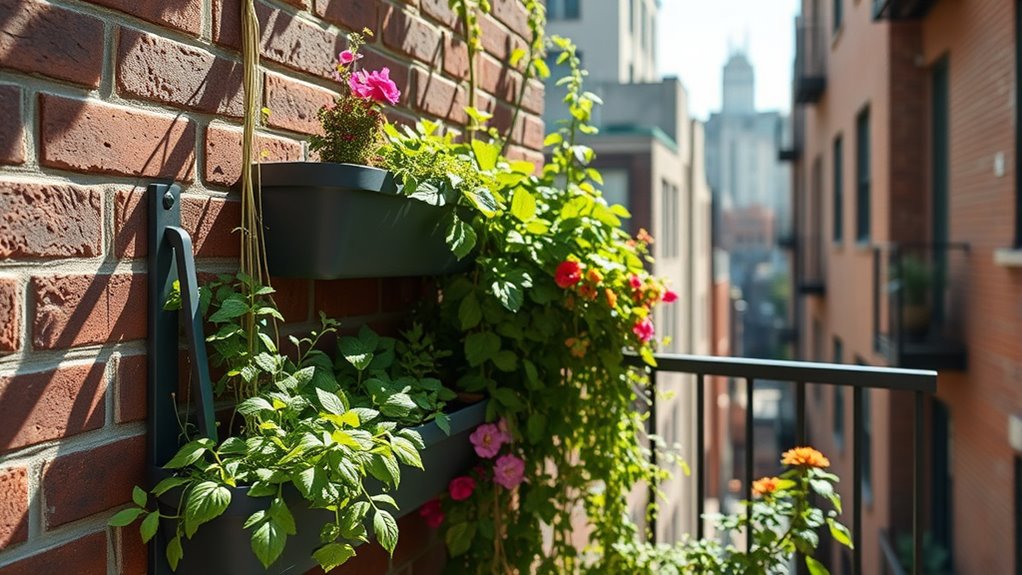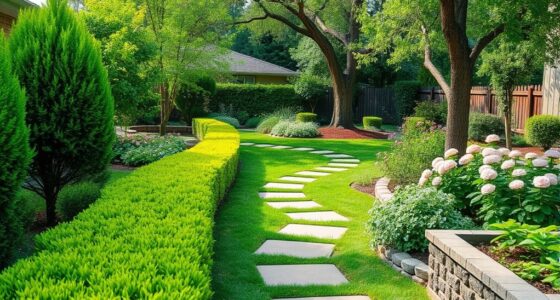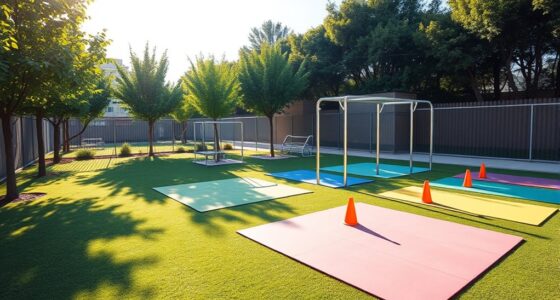Vertical gardening is perfect for small spaces, allowing you to transform blank walls into vibrant green displays that require minimal maintenance. Choose plants like succulents, ferns, and trailing vines suited to your climate, and consider proper irrigation methods to keep them healthy. Layer different textures and heights to create visual interest, making your space feel lush and inviting. Keep exploring to discover tips that will help you build a thriving green wall easily.
Key Takeaways
- Select compact, slow-growing plants like succulents and ferns suited for confined spaces.
- Use vertical planters or wall-mounted systems to maximize small area coverage.
- Incorporate a variety of foliage textures and heights for visual interest and depth.
- Implement self-watering or drip irrigation to simplify maintenance in limited spaces.
- Choose resilient plants that tolerate urban pollution and variable sunlight conditions.

Have you ever considered transforming blank walls into lush, green spaces? Vertical gardening offers an innovative way to maximize small areas while enhancing urban aesthetics. Instead of letting your walls go unused, you can turn them into vibrant, living art. When choosing plants, focus on those that thrive in confined spaces and require minimal maintenance. Select a variety of foliage to add texture and color, creating a dynamic visual display. Consider succulents, ferns, or trailing vines, which are well-suited for vertical setups. Proper plant selection is key to ensuring your garden remains healthy and visually appealing over time.
Transform blank walls into vibrant, low-maintenance green art with succulents, ferns, and trailing vines.
As you plan your vertical garden, think about the overall aesthetic you want to achieve. The right plant choices can transform a dull wall into a focal point that complements your home or apartment. For a modern look, go with sleek, monochromatic greenery like snake plants or pothos. If you prefer a more lively vibe, mix in flowering plants or those with variegated leaves. Furthermore, choosing plants that suit your local climate will make maintenance easier and increase longevity. In urban environments, resilience matters, so pick species that can withstand pollution, limited sunlight, and fluctuating temperatures.
Plant selection also involves considering the growth habits and watering needs of your chosen greenery. Compact, slow-growing plants are ideal for small spaces because they won’t overcrowd your wall over time. Self-watering planters or drip irrigation systems can simplify your routine and prevent overwatering or underwatering. Remember to incorporate a variety of heights and textures to create depth and visual interest. For example, placing trailing plants at the top and upright varieties toward the bottom can give your vertical garden a natural, layered appearance.
Beyond aesthetics, a well-thought-out plant selection can improve your living environment. Greenery helps filter air pollutants, boosts mood, and adds a sense of tranquility to urban life. When designing your vertical garden, think about how much sunlight your wall receives throughout the day. Choose plants accordingly—shade-loving species for darker spots or sun-loving varieties if your wall faces direct sunlight. This tailored approach ensures your plants flourish, making your vertical garden a sustainable and attractive feature.
Additionally, understanding urban environmental factors can help you select the most resilient plants for your vertical garden. In essence, turning bare walls into lush gardens is an excellent way to bring nature into limited spaces. With thoughtful plant selection and a focus on urban aesthetics, you can craft a vibrant, low-maintenance green wall that elevates your home and enriches your daily environment.
Frequently Asked Questions
What Are the Best Plants for Vertical Gardens in Shaded Areas?
You should choose shade-tolerant plants for your vertical garden in shaded areas. Opt for low light greenery like ferns, hostas, and impatiens, which thrive with minimal sunlight. These plants adapt well to low-light conditions and add lushness to your vertical space. By selecting the right shade-tolerant plants, you’ll create a vibrant, green wall that flourishes even in the darkest corners of your garden.
How Do I Prevent Pests in My Vertical Garden?
Pests can turn your lush vertical garden into a battleground, but you can outsmart them. You should practice companion planting, pairing plants that repel pests naturally, and use natural repellents like neem oil or garlic spray regularly. Keep your garden healthy and clean to prevent infestations. Regularly inspect your plants for early signs of pests, acting swiftly to protect your vibrant green masterpiece from being overrun.
What Irrigation Systems Work Best for Small Vertical Setups?
For small vertical setups, drip irrigation and self-watering systems work best. Drip irrigation delivers water directly to your plants’ roots, reducing waste and preventing overwatering. Self-watering systems are easy to maintain, using reservoirs to keep your plants consistently hydrated. Both options save space, minimize mess, and keep your garden healthy. Choose the one that fits your setup and watering needs, making your vertical garden low-maintenance and thriving.
How Often Should I Fertilize My Vertical Garden?
Think of your vertical garden as a thriving soul that needs nourishing. You should fertilize it every 2-4 weeks, depending on plant needs, to keep soil nutrients rich. During active growth, more frequent fertilization benefits your plants, but in dormant periods, cut back. Follow a consistent fertilization schedule to make certain your plants flourish, much like a well-tended garden of dreams, with healthy soil nutrients supporting each vibrant leaf and blossom.
Can Vertical Gardens Be Suitable for Edible Vegetables?
Yes, vertical gardens are perfect for growing edible vegetables. You can use companion planting to improve growth and deter pests, while choosing the right soil guarantees healthy roots. Opt for lightweight, nutrient-rich soil suited for container or vertical setups. Regularly water and fertilize to keep your vegetables thriving. With proper soil selection and strategic companion planting, your vertical garden becomes an efficient, space-saving way to enjoy fresh produce.
Conclusion
Vertical gardening transforms small spaces into lush, vibrant escapes, proving that size doesn’t limit beauty or growth. While your walls may seem confined, they hold limitless potential for life and color. As you nurture plants upward, you realize that limitations often foster creativity. In embracing vertical gardens, you discover that even the tiniest spaces can flourish, reminding you that sometimes, the biggest beauty arises from the smallest corners. Your small space becomes a affirmation to endless possibility.









